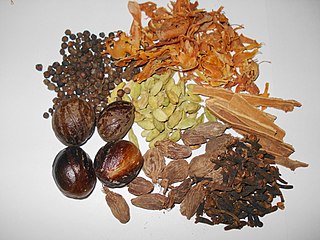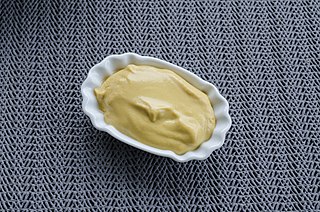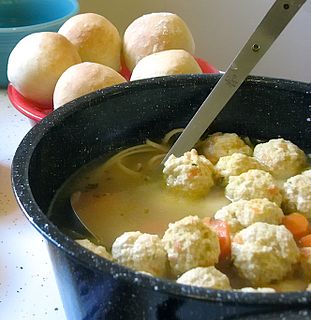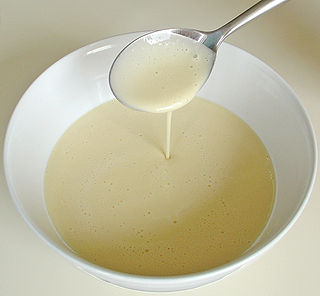Related Research Articles

Five-spice powder is a spice mixture of five or more spices used predominantly in almost all branches of Chinese cuisine. It is also used in Hawaiian cuisine and Vietnamese cuisine. The five flavors of the spices refers to the five traditional Chinese elements.

A pie is a baked dish which is usually made of a pastry dough casing that contains a filling of various sweet or savoury ingredients. Sweet pies may be filled with fruit, nuts, brown sugar, sweetened vegetables, or with thicker fillings based on eggs and dairy. Savoury pies may be filled with meat, eggs and cheese (quiche) or a mixture of meat and vegetables.

The Forme of Cury is an extensive 14th-century collection of medieval English recipes. Although the original manuscript is lost, the text appears in nine manuscripts, the most famous in the form of a scroll with a headnote citing it as the work of "the chief Master Cooks of King Richard II". The name The Forme of Cury is generally used for the family of recipes rather than any single manuscript text. It is among the oldest extant English cookery books, and the earliest known to mention olive oil, gourds, and spices such as mace and cloves.

Pirozhki are Russian and Ukrainian baked or fried yeast-leavened boat-shaped buns with a variety of fillings. Pirozhki are a popular street food and comfort food in Eastern Europe.

A samosa or singara is a fried South Asian pastry with a savory filling, including ingredients such as spiced potatoes, onions, and peas. It may take different forms, including triangular, cone, or half-moon shapes, depending on the region. Samosas are often accompanied by chutney, and have origins in medieval times or earlier. Samosas are a popular entrée, appetizer, or snack in the cuisines of South Asia, the Middle East, Central Asia, East Africa and their South Asian diasporas.

Spice mixes are blended spices or herbs. When a certain combination of herbs or spices is called for in a recipe, it is convenient to blend these ingredients beforehand. Blends such as chili powder, curry powder, herbes de Provence, garlic salt, and other seasoned salts are traditionally sold pre-made by grocers, and sometimes baking blends such as pumpkin pie spice are also available. These spice mixes are also easily made by the home cook for later use.

Mincemeat is a mixture of chopped dried fruit, distilled spirits and spices, and often beef suet, usually used as a pie or pastry filling. Mincemeat formerly contained meat, notably beef or venison. Many modern recipes replace the suet with vegetable shortening. Mincemeat is found in the Anglosphere.

Arab cuisine is the cuisine of the Arabs, defined as the various regional cuisines spanning the Arab world, from the Maghreb to the Fertile Crescent and the Arabian Peninsula. These cuisines are centuries old and reflect the culture of trading in baharat (spices), herbs, and foods. The regions have many similarities, but also unique traditions. They have also been influenced by climate, cultivation, and mutual commerce.

Manti is a type of dumpling popular in most cuisines of the South Caucasus, Balkans, Central Asia, and Afghanistan. Manti is also popular among Chinese Muslims, and it is consumed throughout post-Soviet countries, where the dish spread from the Central Asian republics. The dumplings typically consist of a spiced meat mixture, usually lamb or ground beef, wrapped in a thin dough sheet which is then boiled or steamed. The size and shape of manti vary significantly depending on geographic location.

Onion powder is dehydrated, ground onion that is commonly used as a seasoning. It is a common ingredient in seasoned salt and spice mixes, such as beau monde seasoning. Some varieties are prepared using toasted onion. White, yellow and red onions may be used. Onion powder is a commercially prepared food product that has several culinary uses. Onion powder can also be homemade.
Armenian cuisine includes the foods and cooking techniques of the Armenian people and traditional Armenian foods and dishes. The cuisine reflects the history and geography where Armenians have lived as well as sharing outside influences from European and Levantine cuisines. The cuisine also reflects the traditional crops and animals grown and raised in Armenian-populated areas.

Bobotie is a well-known South African dish consisting of spiced minced meat baked with an egg-based topping.

Sponge cake is a light cake made with egg whites, flour and sugar, sometimes leavened with baking powder. Sponge cakes, leavened with beaten eggs, originated during the Renaissance, possibly in Spain. The sponge cake is thought to be one of the first of the non-yeasted cakes, and the earliest attested sponge cake recipe in English is found in a book by the English poet Gervase Markham, The English Huswife, Containing the Inward and Outward Virtues Which Ought to Be in a Complete Woman (1615). Still, the cake was much more like a cracker: thin and crispy. Sponge cakes became the cake recognized today when bakers started using beaten eggs as a rising agent in the mid-18th century. The Victorian creation of baking powder by English food manufacturer Alfred Bird in 1843 allowed the addition of butter to the traditional sponge recipe, resulting in the creation of the Victoria sponge. And today our celebrations are incomplete without cakes. Cakes are available in millions of flavours and have many recipes as well. Sponge cakes have become snack cakes via the Twinkie.

Mustard is a condiment made from the seeds of a mustard plant.

A meatball is ground meat rolled into a ball, sometimes along with other ingredients, such as bread crumbs, minced onion, eggs, butter, and seasoning. Meatballs are cooked by frying, baking, steaming, or braising in sauce. There are many types of meatballs using different types of meats and spices. The term is sometimes extended to meatless versions based on vegetables or fish; the latter are also commonly known as fishballs.
Powder-douce is a spice mix used in Medieval and Renaissance cookery. Like modern spice mixes such as "Italian seasoning," "garam masala," "taco seasoning," etc., there was not a set ingredient list, it varied from cook to cook. The author of the 14th-century manuscript Le Ménagier de Paris suggested a mix of grains of paradise, ginger, cinnamon, nutmeg, sugar, and galangal.
Beau Monde seasoning is a seasoning mixture. Basic versions are composed of salt, onion powder and celery powder. Some versions include additional ingredients such as garlic, clove, bay leaf, nutmeg, allspice, mace and others. The company Spice Islands manufactures a version of the seasoning and owns the trademark to the name.

Sharbat is a drink prepared from fruit or flower petals. It is a sweet cordial, and usually served chilled. It can be served in concentrated form and eaten with a spoon or diluted with water to create the drink.

Batter is a flour mixture with liquid and other ingredients such as sugar, salt and leavening used for cooking. Batter is most often used for pancakes, light cakes, and as a coating for fried foods. It is also used for a variety of batter breads.
Pie in American cuisine has roots in English cuisine and has evolved over centuries to adapt to American cultural tastes and ingredients. The creation of flaky pie crust shortened with lard is credited to American innovation.
References
- ↑ Adamson, Melitta Weiss (2004). Food in Medieval Times. Greenwood. p. 66. ISBN 9780313321474.
- ↑ Mead, William Edward (1931). The English Medieval Feast. Taylor & Francis. ISBN 9780429514203.
- ↑ The Oxford Companion to Food. Oxford University Press. 2014. p. 766. ISBN 978-0-19-967733-7.